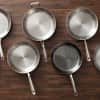Always Finish Pan Sauces with Butter Off Heat
When a recipe calls for finishing a sauce with butter, why must it be added off the heat?
Finishing a pan sauce with butter adds three things: flavor, richness, and body. To achieve the last of these, you need to remove the pan from the heat before stirring in the butter. Why? Because butter is an emulsion, a mixture of two things that ordinarily do not mix well. This particular emulsion is of water in fat; standard American butter is about 16 percent water and 80 percent fat. What binds these two ordinarily unfriendly molecules is a third type of molecule, called a phospholipid, which has a tail that attracts water and a head that weakly attracts fats. As long as there is enough phospholipid to coat the water droplets, the emulsion will be stable. But when you introduce butter into a liquid, as you do when finishing a sauce, suddenly there are many more water molecules than fat molecules, and there is too little phospholipid to go around. If you leave the sauce on the heat, the heat causes the molecules to move faster and jostle one another more, which makes it just that much harder for the phospholipid to hold on to the fat and water molecules. The result? At about 160 degrees, the fat separates out from the water, and instead of a nicely thickened sauce, what you have is a liquid with a pool of floating fat.
THE BOTTOM LINE: Add butter to pan sauces off heat to prevent the butter from separating and leaving an oil slick on top.
DON'T DO IT: This sauce broke because the butter was added on the heat.


